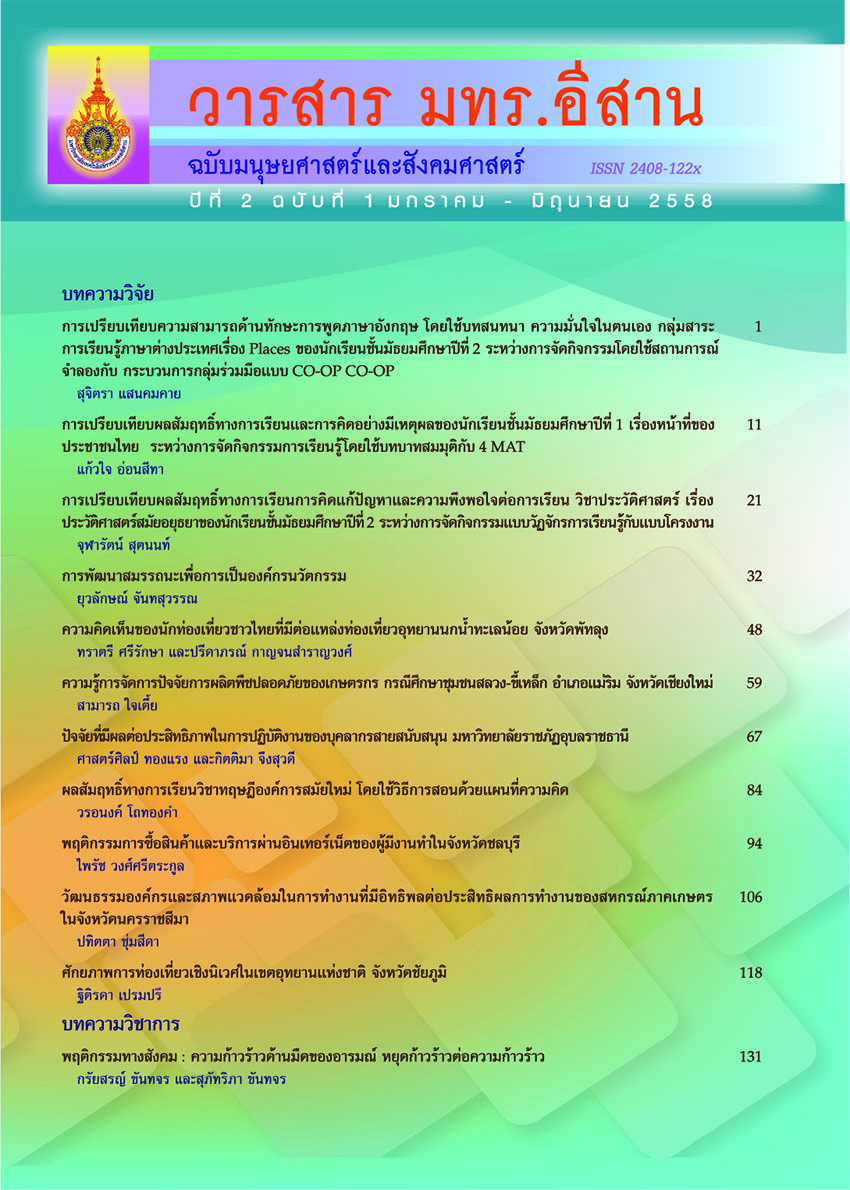Quality of Work Life and Achievement Motivation Affecting Job Effectiveness of the Personnel of the Bank for Agricultural Co-Operatives
Main Article Content
Abstract
This research aims to study the quality of work life and achievement motivation affecting job effectiveness of the personnel of the Bank for Agriculture and Agricultural Co-operatives. The sample of 236 personnel of the Bank for Agriculture and Agricultural Co-operatives. Data analysis statistics included percentages, means, standard deviations and multiple regressions. The results showed that achievement motivation variable overview is higher than the average quality of work life. Achievement motivation in the overall average is at the highest level. The result of this study showed that quality of work life and achievement motivation affect job effectiveness. The quality of work life 5 - side in terms of adequate and fair compensation, safe and healthy environment, growth and security, development of human capabilities and constitutionalism. Has found that job effectiveness is development of human capabilities and adequate and fair compensation. While achievement motivation 4 - side in terms of energetic, moderate risk taking, individual responsibility and long range planning or anticipation of future. Has found that job effectiveness is long range planning or anticipation of future. The quality of work life and achievement motivation of the 9 - side variables that predict job effectiveness, 55.20 percent are statistically significant level of 0.05.
Article Details
บทความที่ได้รับการตีพิมพ์เป็นลิขสิทธิ์ของมหาวิทยาลัยเทคโนโลยีราชมงคลอีสาน
ข้อความที่ปรากฏในบทความแต่ละเรื่องในวารสารวิชาการเล่มนี้เป็นความคิดเห็นส่วนตัวของผู้เขียนแต่ละท่านไม่เกี่ยวข้องกับมหาวิทยาลัยเทคโนโลยีราชมงคลอีสานและคณาจารย์ท่านอื่นๆในมหาวิทยาลัยฯ แต่อย่างใด ความรับผิดชอบองค์ประกอบทั้งหมดของบทความแต่ละเรื่องเป็นของผู้เขียนแต่ละท่าน หากมีความผิดพลาดใดๆ ผู้เขียนแต่ละท่านจะรับผิดชอบบทความของตนเองแต่ผู้เดียว
References
บุญใจ ศรีสถิตย์นรากูร. (2550). ระเบียบวิธีการวิจัยทางพยาบาลศาสตร์. กรุงเทพมหานคร: บริษัท ยูแอนด์ไออินเตอร์ มีเดีย จำกัด
เบญจรัตน์ เหลือล้น. (2553). การรับรู้ลักษณะงาน แรงจูงใจใฝ่สัมฤทธิ์กับการปฏิบัติงานของพยาบาลดูแลผู้ป่วยล้างไตทางช่องท้องอย่างต่อเนื่องในระบบหลักประกันสุขภาพถ้วนหน้า. วิทยานิพนธ์ปริญญาสาธารณสุขศาสตรมหาบัณฑิต สาขาวิชาวิทยาศาสตร์สุขภาพ. กรุงเทพมหานคร : มหาวิทยาลัยสุโขทัยธรรมาธิราช
ภัทรานี ศรีประมวล และกิตติพันธ์ คงสวัสดิ์เกียรติ. (2556). ความพึงพอใจในการปฏิบัติหน้าที่ของข้าราชการตำรวจกองกำกับการ 1 กองบังคับการปราบปราม. วารสารการเงิน การลงทุนการตลาด และการบริหารธุรกิจ. ปีที่ 3. ฉบับที่ 4. หน้า 100-116
อารวย ดีเลิศ. (2549). ประสิทธิผลในการปฏิบัติงานของพนักงานตรวจสอบภายใน ธนาคารเพื่อการเกษตรและสหกรณ์การเกษตร. ปริญญารัฐประศาสนศาสตร์มหาบัณฑิต สาขาบริหารทั่วไป. ชลบุรี: มหาวิทยาลัยบูรพา
อุดม พินธุรักษ์. (2553). ความสัมพันธ์ระหว่างภาวะผู้นำการเปลี่ยนแปลงของผู้บริหารสถานศึกษากับประสิทธิผลการบริหารงานบุคคลโรงเรียนประถมศึกษา สังกัดส่านักงานเขตพื้นที่การศึกษาอุดรธานี.วิทยานิพนธ์ครุศาสตรมหาบัณฑิต. สาขาวิชาการบริหารการศึกษา. อุดรธานี : มหาวิทยาลัยราชภัฏอุดรธานี
Barney, J. B. (1991). Firm resources and sustained competitive advantage. Journal of Management. Vol. 17. No. 1 pp. 99-120
Huse, E. F and Cumming, T. G. (1985). Organization development and change. Minneapolis: West Publishing
MeCelland, D. C. (1961). The Achieving Society. Princeton: D. Van Nonstrand Company, Inc.
Penrose, E. T. (1959). The Theory of the Growth of the Firm. Basil Blackwell. Oxford.
Rovinelli, R. J. and Hambleton, R. K. (1997). On the use of content specialists in the assessment of criterion-referenced test item validity. Dutch Journal of Educational Research.
Steers, Richard M. (1981). Introduction to Organizational Behavior. Glenview : Scott, Foresman and Company.
Walton, R. E. (1973). Quality of working life. Sloan Management Review. Vol. 15. No. 1. pp.11-12
Wernerfelt, B. (1984). A Resource-Based View of the Firm. Strategic Management Journal. Vol. 5. No. 2. pp.171-180


